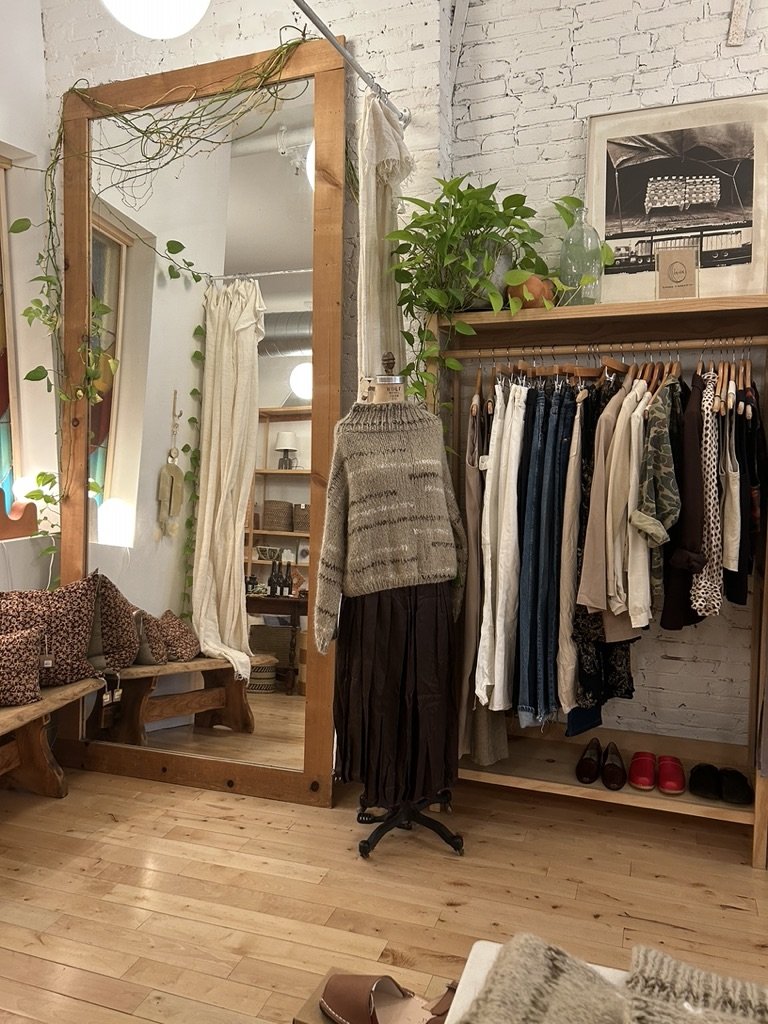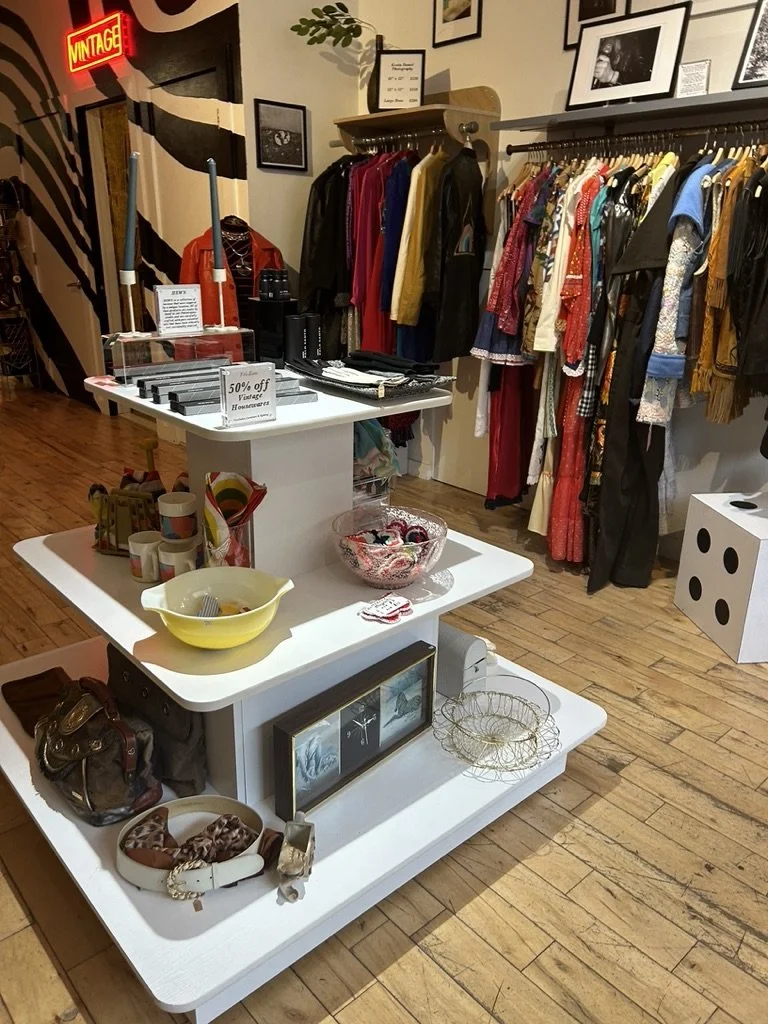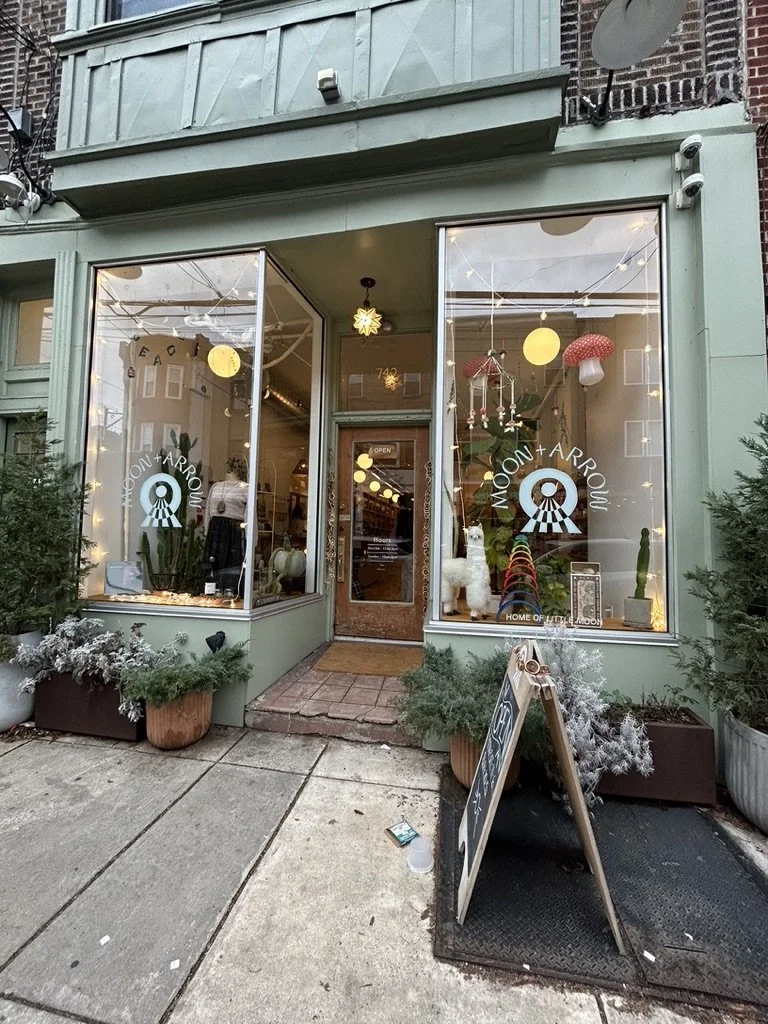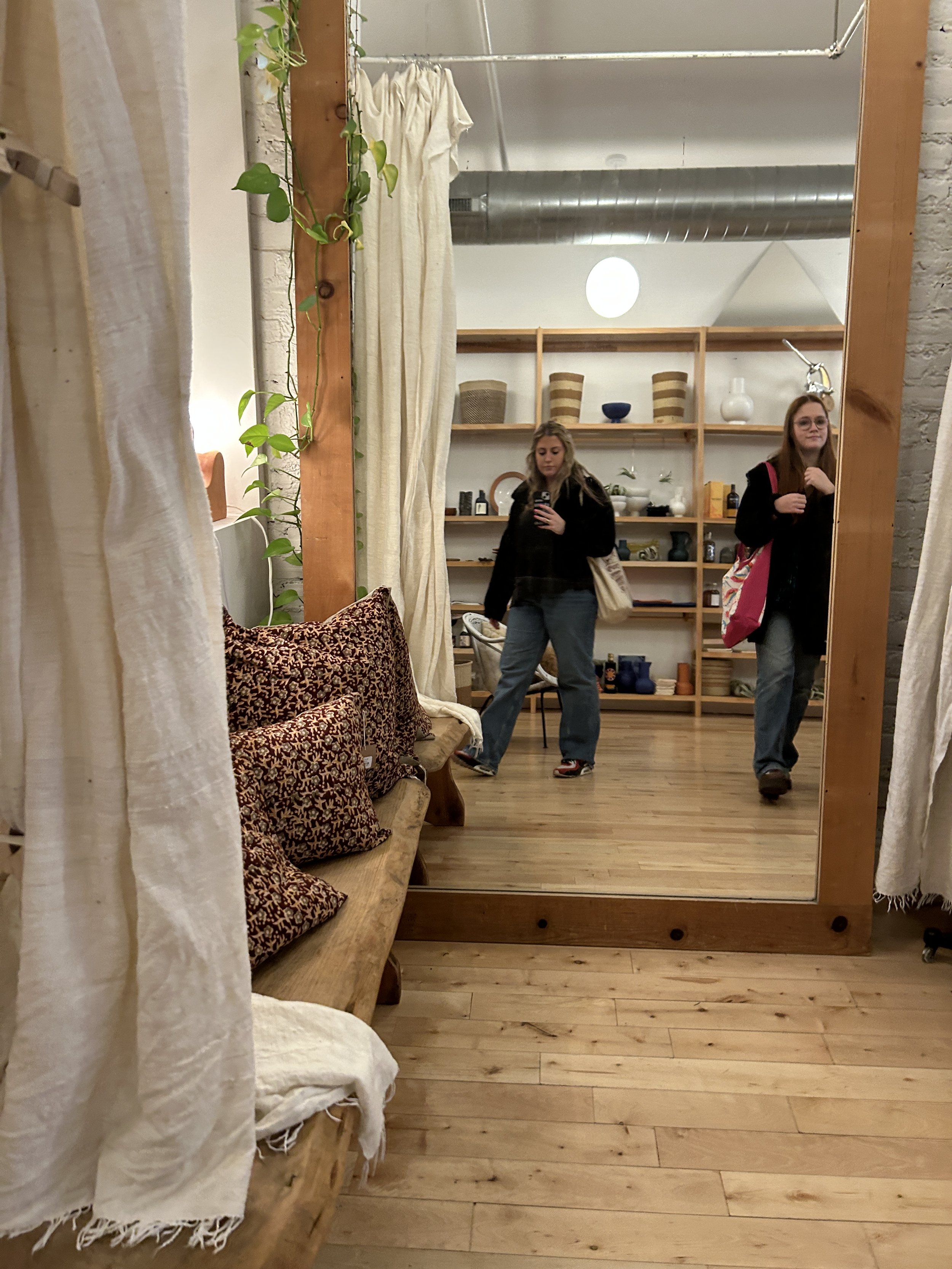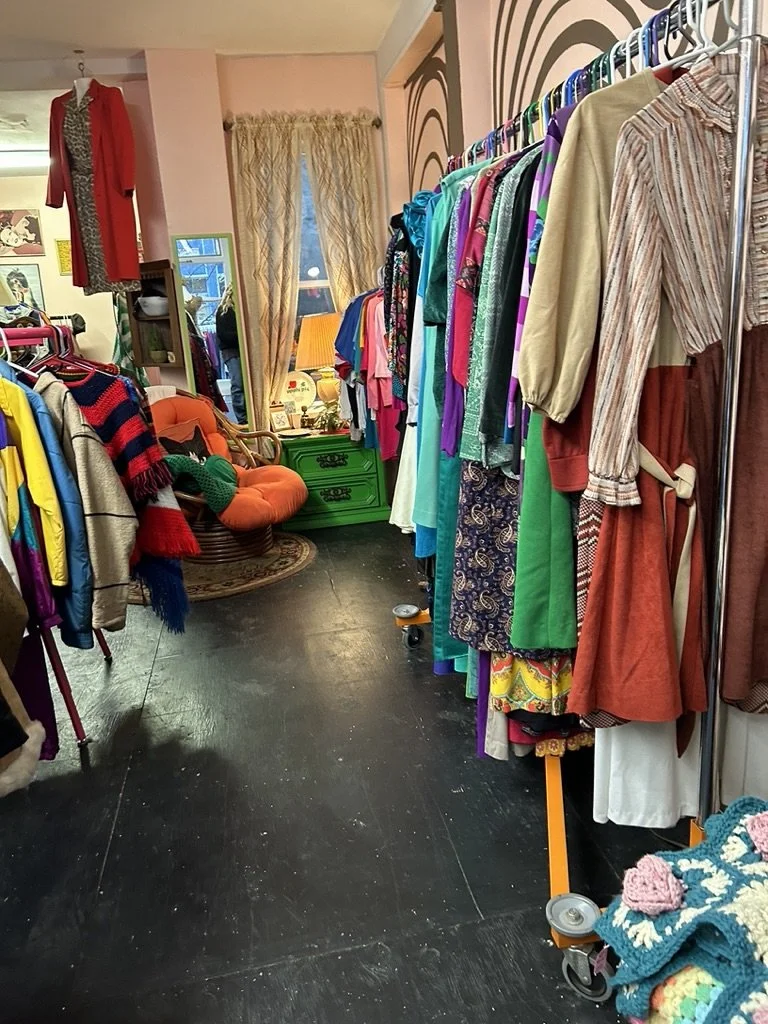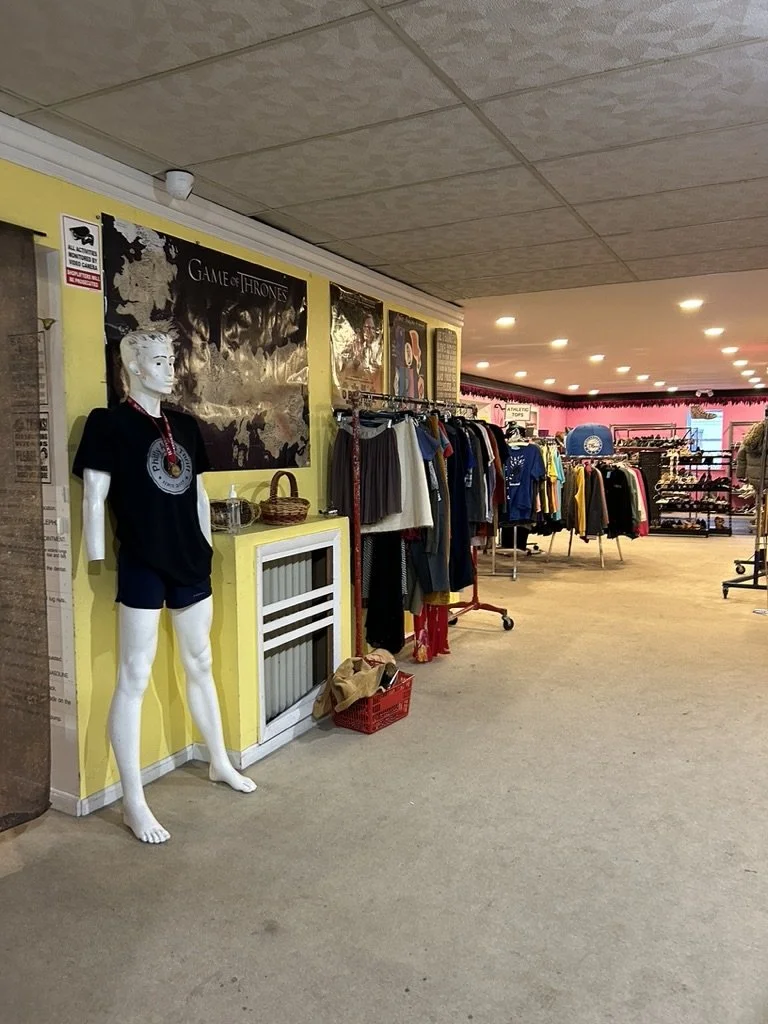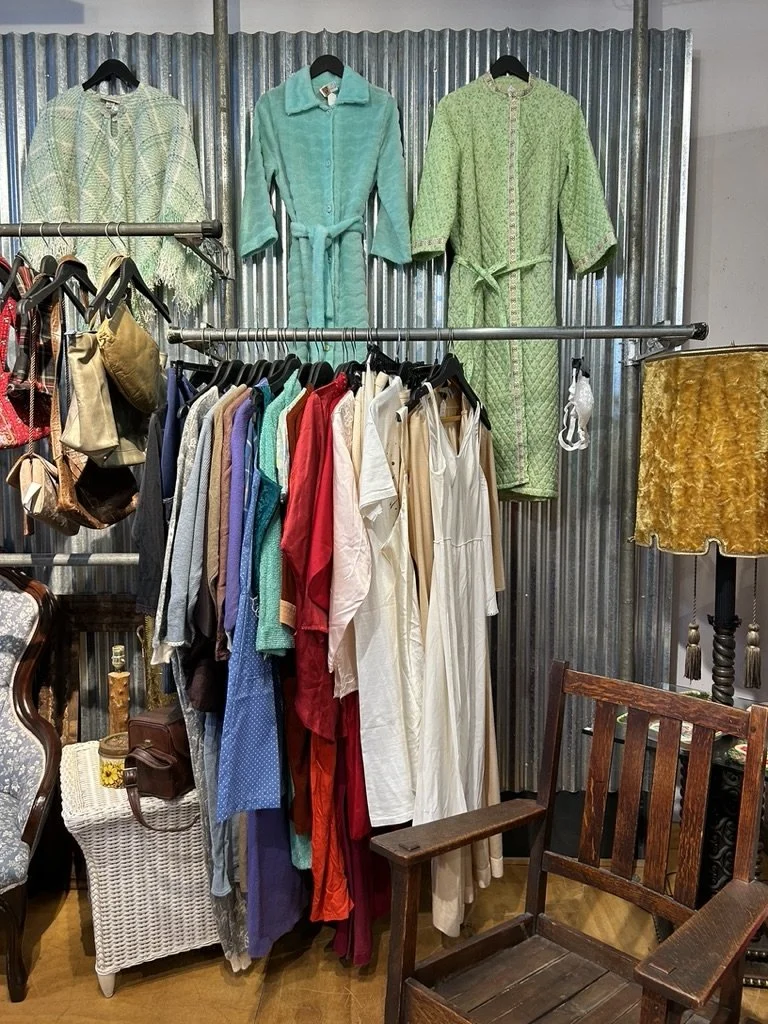Something Old, Something New
Written by: Holly Cambareri
It’s out with the old and in with the new…wait, never mind. We’ve decided to embrace the old and learn to shop secondhand. MAVEN visits several of Philly’s most famous thrift stores!
As D&M students, we talk about sustainable fashion every single day. Sustainable fashion refers to clothing, shoes, and accessories that are designed, manufactured, and distributed in environmentally friendly ways and value animal welfare and workers’ rights. Although I’ve done a tremendous amount of research, I continue to purchase from companies that are part of the problem. While I don’t shop at the worst fast fashion retailers like Shein or H&M, I do frequent Urban Outfitters, Free People, and Abercrombie & Fitch, which are far from ethical brands. While it is essential to shop sustainably, it can also be challenging. Sustainable fashion is far more expensive than fast fashion, as sustainable brands use better quality, ethically sourced materials and have ethical labor practices, paying their employees fair wages. For many consumers, shopping from sustainable brands is not financially sustainable, which leads me to secondhand shopping.
It feels like 90% of the time, I compliment a friend or peer on their outfit and ask where they got it from, and their response is, “I thrifted it!” Secondhand shopping, like vintage resale and thrifting, can be a sustainable alternative to fast fashion while still being less expensive than buying new from ethical brands. I love the idea of having a collection of vintage secondhand clothing and knowing I dress in lots of jeans, dresses, and sweatshirts; it shouldn’t be as hard as it has been for me. I’ve tried thrifting, visiting my local Goodwill and Savers stores, and spending what feels like hours sifting through the racks and walking out empty-handed every time. I have visited countless resale vintage stores in New York City, but still nothing. I yearn to find a beautiful, flowing dress, cozy, faded sweatshirt, or set of sparkling glassware in a thrift store, just sitting there and waiting for me to pick it up, but I never seem to be that lucky. After years of frustration, I decided to turn my luck around and explore some of Philly’s favorite thrift and vintage stores to make my shopping more sustainable.
Philly Vintage Bazaar
744 S. 4th Street
The upbeat music playing when we walked into Philly Vintage Bazaar was inviting and the patterns of the walls and clothing were bright and beautiful, creating a cozy and exciting environment. As I browsed the racks of gorgeous sweaters and one-of-a-kind coats, a specific item caught my eye: a stunning black leather jacket with beautiful, large metal studs along the collar and down the arms, though I immediately turned away as I noted the $300 price tag. The store had an extensive denim collection, and I enjoyed sifting through each piece and seeing lots of vintage Lee and Wrangler jeans. A rack in the store’s back corner held lots of belts and shoes selling for cheaper prices, some brown leather belts for $15-20, and black boots for around $50. While I loved the entire product assortment, my favorite part was the vintage houseware scattered around the shelves. The glassware caught my eye, and I could picture the vintage tea sets and glass decanters sitting on my kitchen table surrounded by the rest of my dream vintage glassware collection.
Moon and Arrow
742 S. 4th Street
Moon and Arrow is a socially responsible boutique located right next door to Philly Vintage Bazaar. The clean, bright storefront was appealing right away, and the interior had the same vibe. Moon and Arrow is an excellent place to go if you are browsing for simple gifts like essential oils, candles, jewelry, or ethically produced notebooks. The store’s merchandise comes from local and non-local, ethical vendors, including Injiri, an India-based company emphasizing textile development and sustainable materials. Cozy sweaters made of some of the softest fibers I had ever felt were priced between $200-$300, all produced by independent, ethical artisans. The store also sold vintage jeans from popular brands like Lee and Levi’s that were in excellent condition. While all the clothing was beautiful- bohemian, neutral, and light- it was priced high and not somewhere I could realistically shop as a college student without a disposable income.
B-Bop Vintage
619 S. 4th Street
On the way to our next planned store, we spotted B-Bop Vintage, an adorable vintage store, popping with color and pattern from the rack placed outside the front door to the fitting rooms in the back. The first thing I noticed when I walked in was their vintage jeans, like the other two stores we visited. Their pricing was lower than the previous two, with Lee, Wrangler, and Harley Davidson jeans selling for under $50. A large selection of neon windbreakers, velvet suit jackets, silky blouses, and corduroy pants is available to browse. The clothing is precisely what I expected from a quirky, vintage shop. The clothes all appeared in good condition, though well-loved, some garments featuring a few small rips or stains, adding to the charm. I adored the bright and colorful atmosphere. It felt like each piece of clothing had a reason to be there and a story behind it, especially about a perfect condition red leather blazer or a stunning 70s floral printed button-down.
Philly AIDS Thrift
710 S. 5th Street
We moved on to the famous Philly AIDS Thrift and were welcomed by a stunning rainbow mural painted on the brick exterior of the store, I instantly knew that I would love this stop. Philly AIDS Thrift is a non-profit thrift store that donates its proceeds to local organizations involved in the fight against AIDS. The store comprises two stories, and countless rooms with walls painted bright shades of pink and yellow and covered with stickers, posters, and vintage artwork. The store was bustling, people of all ages piling items in their arms as they slipped through the doorways of rooms labeled “business wear,” “athletic tops,” and even “vintage prom.” I was overwhelmed by the sheer amount of clothing, as each rack had no organization based on sizing or color. I looked at a few tweed blazers in various plaid prints selling for around $15 each and analyzed the shoe selection, surprised to see some old sneakers and boots selling for just $5. I fell in love with a beautiful, crocheted sweater featuring gorgeous shades of baby blue, teal, and cerulean in a swirling pattern, but it was a few sizes too big. While looking at the jackets and coats, I gazed at a tan, faux fur vest that had once been a jacket but was cut to suit the previous owner’s needs. Philly AIDS Thrift truly creates a community unlike any other. It felt like a place where anyone and everyone could go and be welcomed with smiles and open arms.
Retrospect Vintage
508 South Street
Retrospect Vintage can be found directly in the heart of Philly’s famous South Street shopping district. Retrospect is different from the other shops, as it is owned and operated by Goodwill, meaning the best donations received by Goodwill are handpicked and sent there. There they can be sold for higher prices and contribute to the store’s unique and stylish assortment. Much of the clothing matched my style and aesthetic: a huge denim assortment, beautiful lace tops, and colorful floral dresses. It was the only store where I felt compelled to try stuff on, selecting several pairs of jeans and a sheer white top. The prices were lower than expected, with secondhand denim jeans costing around $25. While I didn’t buy anything, my friend purchased a vintage, floral pair of pants that reminded me of a decades-old couch and a cream-colored crocheted poncho, spending $40 on the two pieces. I genuinely loved the product assortment at Retrospect and could have spent hours browsing the racks of cozy sweaters and colorful home décor.
Buffalo Exchange
1520 Chestnut Street
Buffalo Exchange, a chain vintage, secondhand store, has 40 locations across the US. When I visited on a Saturday afternoon, the store was full of people, but it was easy to navigate around and find what I was looking for. There were a lot of products in the store, which was very well organized, though the prices were a little high. I saw several garments from brands such as H&M and Forever 21, including a striped Forever 21 tank top priced at $12, likely more than it sold at its full retail price. I enjoyed my experience shopping at Buffalo Exchange, and the product was far “trendier” and “modern” than at the other stores I visited. Because Buffalo Exchange is a buy, sell, trade store, the employees pick through each item they choose to buy, which creates a high-quality and trendy product offering leading to higher prices overall. And though the prices felt a little steep, they had some great pieces, and the assortment is constantly changing due to their buy, sell, trade model.
Second Mile Center
212 S 45th Street
Second Mile Center is just a short walk from Drexel’s campus, an easy stop for many students. The store appeared more run-down than the other places I visited, but the lights in the window and colorful flyers posted outside created a bright, appealing storefront. The store is well-organized, with labels written in marker on colored paper to ensure the customers can find what they’re looking for. Laundry baskets were filled to the brim with old picture frames, vinyl records, and balls of yarn alongside the metal racks of clothing, shoes, and bags. The bright assortment of clothing seemed never-ending as I browsed through a rack of sleepwear, observing that a pair of warm, flannel pajama pants was only $2.95. A bag immediately caught my eye, small and made of black and white plaid fabric, disrupted by a large hot pink ribbon tied in a bow across the front and featuring light, wooden handles. The colors did not go together at all, and the fabric was beginning to pill, but observing the purse made me wonder about the story of the item, thinking about who it belonged to and where they had brought it.
For someone unfamiliar with secondhand shopping, this was an eye-opening experience. I enjoyed seeing the difference in assortment, aesthetic, and pricing between the stores, as there were many, and I loved a lot of the clothes more than I expected to. While I saw many bold, patterned statement pieces in my shopping journey that didn’t scream “me,” I also saw many basics that I would gladly welcome into my closet, such as jeans, leather jackets, blazers, tops, and shoes. I finally understand the idea of “the hunt” and how much effort it takes to shop secondhand as you find hidden gems. I can’t wait to continue to expand my shopping horizons and move in a more sustainable direction.

